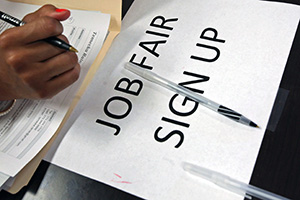Weekly Jobless Claims Decline as Job Market Improves

Fewer Americans than forecast filed jobless claims last week, hovering around levels that are typically associated with an improving job market.
Applications for unemployment benefits increased by 11,000 to 278,000 in the week ended Jan. 31, from a revised 267,000 in the prior period, a Labor Department report showed Feb. 5 in Washington. The median forecast of 50 economists surveyed by Bloomberg News called for a rise to 290,000.
While the holidays make it difficult to adjust the date for seasonal swings this time of year, making the data more volatile, readings this low often correspond with gains in hiring. A Labor Department report on Feb. 6 is expected to show that U.S. payrolls added 230,000 workers in January.
“Given inclement weather this time of the year and the difficulty in seasonally adjusting the figures around holidays, claims are notoriously volatile,” Joseph LaVorgna, chief U.S. economist at Deutsche Bank Securities Inc. in New York, wrote in a research note before the report. “As long as claims remain below 300,000 on a trend basis, we can be reasonably confident that monthly job growth will continue to average well over 200,000.”
All eyes are on Feb. 6, when the Labor Department report is expected to show the world’s largest economy added more than 200,000 jobs for a 12th consecutive month and that unemployment held at 5.6%, a more than six-year low.
Another Labor Department report showed worker productivity dropped in the fourth quarter as employers boosted hours by the most in 16 years, making the cost of labor more expensive. The measure of employee output per hour decreased at a 1.8% annualized rate, after a revised 3.7% gain in the prior three months that was larger than previously estimated.
Economist estimates for jobless claims ranged from 273,000 to 330,000 in the Bloomberg survey. The Labor Department revised the previous week’s figure from an initially reported 265,000.
No states estimated jobless claims last week and there was nothing unusual in the report, a Labor Department spokesman said as the figures were released. Additionally, no states indicated that the blizzard than blanketed the northeast last week prevented workers from filing applications.
The four-week moving average, a less volatile measure than the weekly figures, declined to 292,750 last week, the lowest in more than a month, from 299,250.
The number of people continuing to receive jobless benefits climbed by 6,000 to 2.4 million in the week ended Jan. 24. The unemployment rate among people eligible for benefits held at 1.8%. These data are reported with a one-week lag.
Initial jobless claims reflect weekly firings and typically decline before job growth accelerates.
Other labor market indicators suggest steady momentum in the United States, even as slumping energy prices hurt industries exposed to oil. ADP Research Institute said Feb. 4 that employment at companies climbed 213,000 in January after a 253,000 gain a month earlier that was larger than initially reported.
The improvement in the labor market is enough to justify raising interest rates soon, according to Federal Reserve Bank of Cleveland President Loretta Mester.
“There are accumulating signs that the economy is building momentum,” said Mester, who doesn’t vote this year on the Federal Open Market Committee. “It will soon be appropriate to begin moving rates up from zero. Because policy must be forward looking, in my view liftoff should occur before our goals are fully met.”
Consumer demand and cheap gas are helping companies like Ford Motor Co. create more jobs. The automaker said Feb. 4 that it’s adding workers to help build a new aluminum-bodied pickup in Missouri and Michigan.
“Thanks to stronger-than-expected customer demand, we’re adding 1,550 new workers to support additional F-150 production,” Joe Hinrichs, the Dearborn, Michigan-based company’s president of the Americas, said in a statement. “We sell every truck we can build, and we plan to build more.”
Ford also said it planned to give raises to as many as 500 U.S. hourly employees because new hiring is pushing the company past its limit on lower-wage workers. Ford’s total hourly additions now total more than 15,000 since 2011, exceeding a pledge of 12,000 by 2015.

